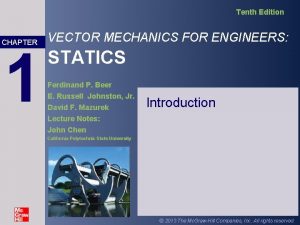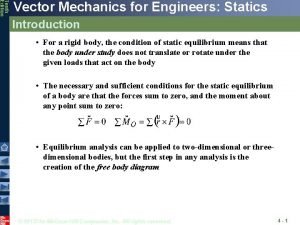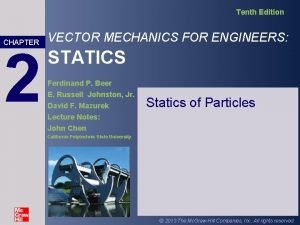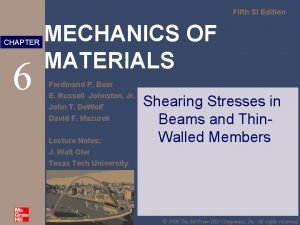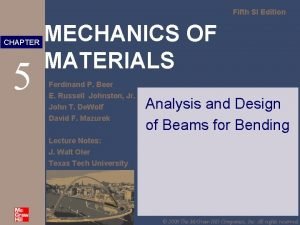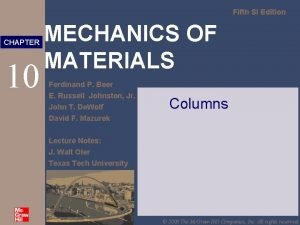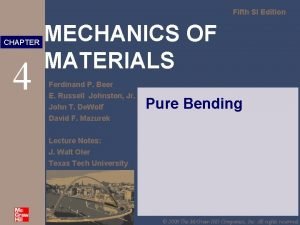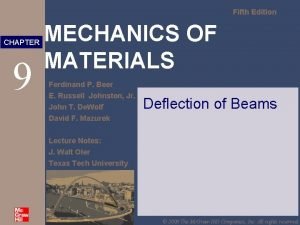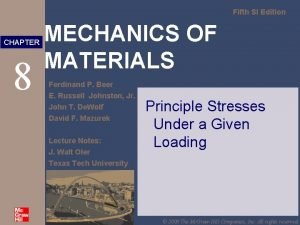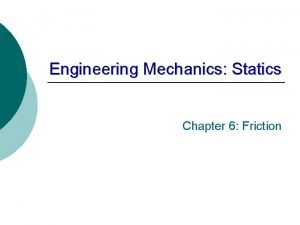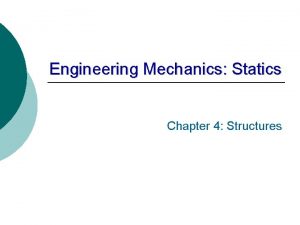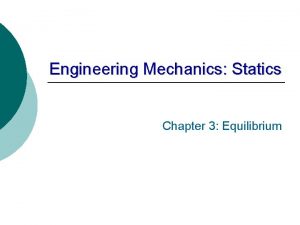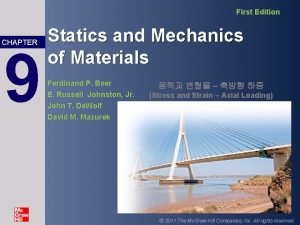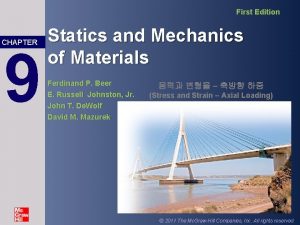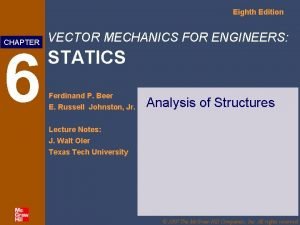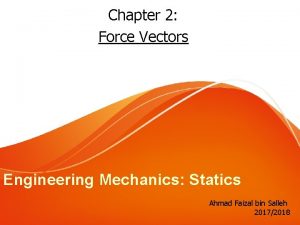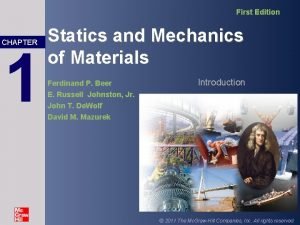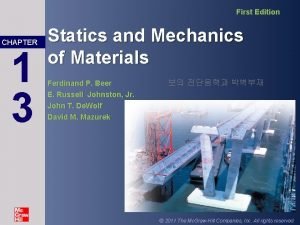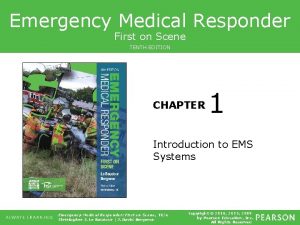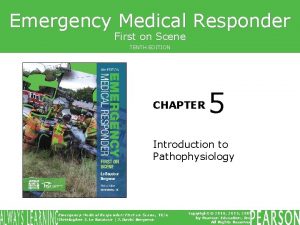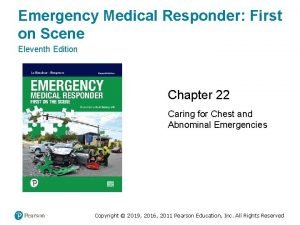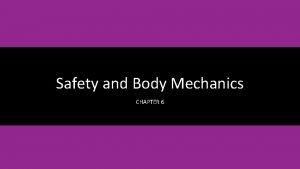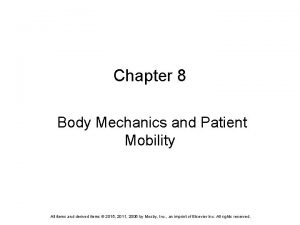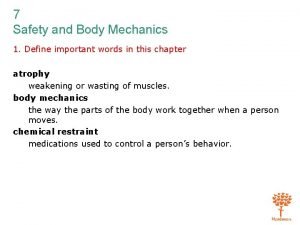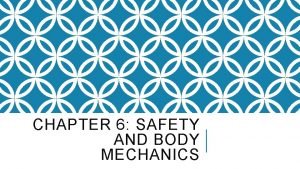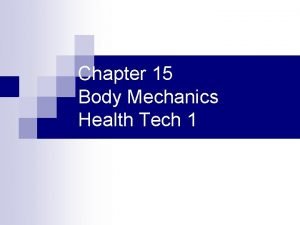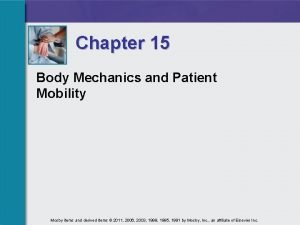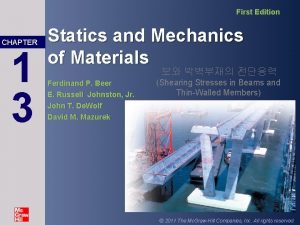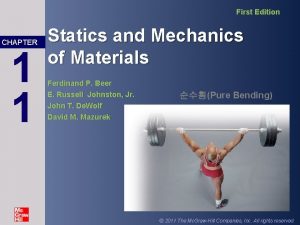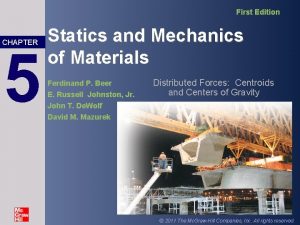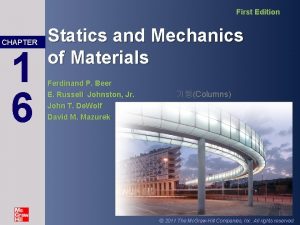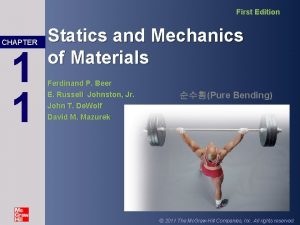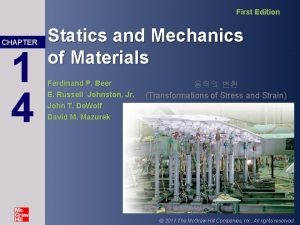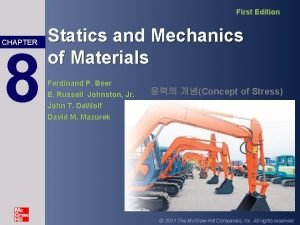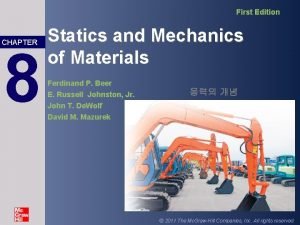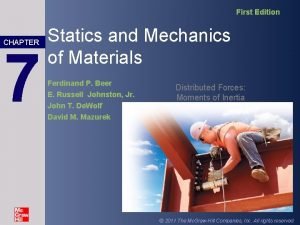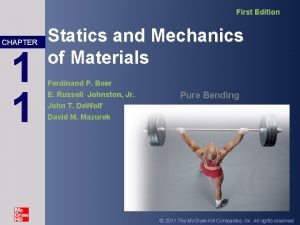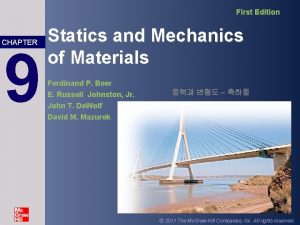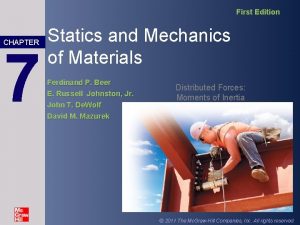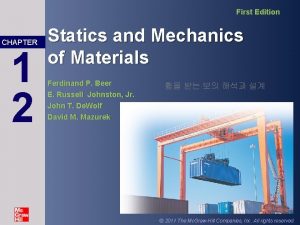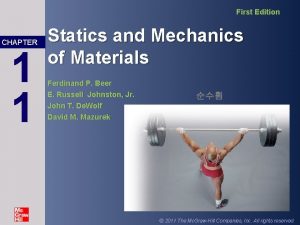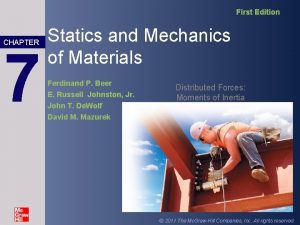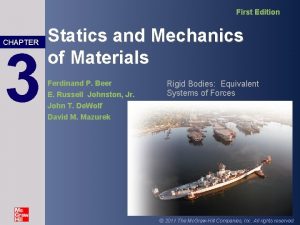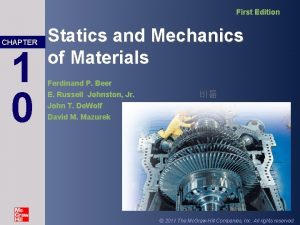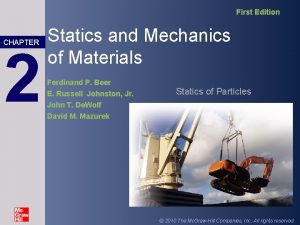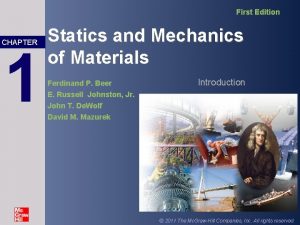First Edition CHAPTER 4 Statics and Mechanics of





































- Slides: 37

First Edition CHAPTER 4 Statics and Mechanics of Materials Ferdinand P. Beer E. Russell Johnston, Jr. John T. De. Wolf Equilibrium of Rigid Bodies David M. Mazurek © 2011 The Mc. Graw-Hill Companies, Inc. All rights reserved.

First Edition Statics and Mechanics of Materials Contents Introduction Free-Body Diagram Equilibrium of a Rigid Body in Three Dimensions Reactions at Supports and Connections for a Two. Dimensional Structure Reactions at Supports and Connections for a Three-Dimensional Structure Equilibrium of a Rigid Body in Two Dimensions Friction Sample Problem 4. 8 Statically Indeterminate Reactions Laws of Dry Friction. Coefficients of Friction. Sample Problem 4. 1 Angles of Friction Sample Problem 4. 3 Problems Involving Dry Friction Sample Problem 4. 4 Sample Problem 4. 11 Equilibrium of a Two-Force Body Sample Problem 4. 13 Equilibrium of a Three-Force Body Sample Problem 4. 6 © 2011 The Mc. Graw-Hill Companies, Inc. All rights reserved. 4 -2

First Edition Statics and Mechanics of Materials Introduction • For a rigid body in static equilibrium, the external forces and moments are balanced and will impart no translational or rotational motion to the body. • The necessary and sufficient condition for the static equilibrium of a body are that the resultant force and couple from all external forces form a system equivalent to zero, • Resolving each force and moment into its rectangular components leads to 6 scalar equations which also express the conditions for static equilibrium, © 2011 The Mc. Graw-Hill Companies, Inc. All rights reserved. 4 -3

First Edition Statics and Mechanics of Materials Free-Body Diagram First step in the static equilibrium analysis of a rigid body is identification of all forces acting on the body with a free-body diagram. • Select the extent of the free-body and detach it from the ground all other bodies. • Indicate point of application, magnitude, and direction of external forces, including the rigid body weight. • Indicate point of application and assumed direction of unknown applied forces. These usually consist of reactions through which the ground and other bodies oppose the possible motion of the rigid body. • Include the dimensions necessary to compute the moments of the forces. © 2011 The Mc. Graw-Hill Companies, Inc. All rights reserved. 4 -4

First Edition Statics and Mechanics of Materials Reactions at Supports and Connections for a Two-Dimensional Structure • Reactions equivalent to a force with known line of action. © 2011 The Mc. Graw-Hill Companies, Inc. All rights reserved. 4 -5

First Edition Statics and Mechanics of Materials Reactions at Supports and Connections for a Two-Dimensional Structure • Reactions equivalent to a force of unknown direction and magnitude and a couple. of unknown magnitude © 2011 The Mc. Graw-Hill Companies, Inc. All rights reserved. 4 -6

First Edition Statics and Mechanics of Materials Equilibrium of a Rigid Body in Two Dimensions • For all forces and moments acting on a twodimensional structure, • Equations of equilibrium become where A is any point in the plane of the structure. • The 3 equations can be solved for no more than 3 unknowns. • The 3 equations can not be augmented with additional equations, but they can be replaced © 2011 The Mc. Graw-Hill Companies, Inc. All rights reserved. 4 -7

First Edition Statics and Mechanics of Materials Statically Indeterminate Reactions • More unknowns than equations • Fewer unknowns than • Equal number unknowns and equations but equations, partially improperly constrained © 2011 The Mc. Graw-Hill Companies, Inc. All rights reserved. 4 -8

First Edition Statics and Mechanics of Materials Sample Problem 4. 1 SOLUTION: • Create a free-body diagram for the crane. • Determine B by solving the equation for the sum of the moments of all forces about A. Note there will be no contribution from the unknown reactions at A. A fixed crane has a mass of 1000 kg and is used to lift a 2400 kg crate. It is held in place by a pin at A and a rocker at B. The center of gravity of the crane is located at G. Determine the components of the reactions at A and B. • Determine the reactions at A by solving the equations for the sum of all horizontal force components and all vertical force components. • Check the values obtained for the reactions by verifying that the sum of the moments about B of all forces is zero. © 2011 The Mc. Graw-Hill Companies, Inc. All rights reserved. 4 -9

First Edition Statics and Mechanics of Materials Sample Problem 4. 1 • Determine B by solving the equation for the sum of the moments of all forces about A. • Create the free-body diagram. • Determine the reactions at A by solving the equations for the sum of all horizontal forces and all vertical forces. • Check the values obtained. © 2011 The Mc. Graw-Hill Companies, Inc. All rights reserved. 4 - 10

First Edition Statics and Mechanics of Materials Sample Problem 4. 3 SOLUTION: • Create a free-body diagram for the car with the coordinate system aligned with the track. • Determine the reactions at the wheels by solving equations for the sum of moments about points above each axle. • Determine the cable tension by solving A loading car is at rest on an inclined the equation for the sum of force track. The gross weight of the car and components parallel to the track. its load is 5500 lb, and it is applied at at G. The cart is held in position by • Check the values obtained by verifying the cable. that the sum of force components perpendicular to the track are zero. Determine the tension in the cable and the reaction at each pair of wheels. © 2011 The Mc. Graw-Hill Companies, Inc. All rights reserved. 4 - 11

First Edition Statics and Mechanics of Materials Sample Problem 4. 3 • Determine the reactions at the wheels. • Create a free-body diagram • Determine the cable tension. © 2011 The Mc. Graw-Hill Companies, Inc. All rights reserved. 4 - 12

First Edition Statics and Mechanics of Materials Sample Problem 4. 4 SOLUTION: • Create a free-body diagram for the frame and cable. • Solve 3 equilibrium equations for the reaction force components and couple at E. The frame supports part of the roof of a small building. The tension in the cable is 150 k. N. Determine the reaction at the fixed end E. © 2011 The Mc. Graw-Hill Companies, Inc. All rights reserved. 4 - 13

First Edition Statics and Mechanics of Materials Sample Problem 4. 4 • Solve 3 equilibrium equations for the reaction force components and couple. • Create a free-body diagram for the frame and cable. © 2011 The Mc. Graw-Hill Companies, Inc. All rights reserved. 4 - 14

First Edition Statics and Mechanics of Materials Equilibrium of a Two-Force Body • Consider a plate subjected to two forces F 1 and F 2 • For static equilibrium, the sum of moments about A must be zero. The moment of F 2 must be zero. It follows that the line of action of F 2 must pass through A. • Similarly, the line of action of F 1 must pass through B for the sum of moments about B to be zero. • Requiring that the sum of forces in any direction be zero leads to the conclusion that F 1 and F 2 must have equal magnitude but opposite sense. © 2011 The Mc. Graw-Hill Companies, Inc. All rights reserved. 4 - 15

First Edition Statics and Mechanics of Materials Equilibrium of a Three-Force Body • Consider a rigid body subjected to forces acting at only 3 points. • Assuming that their lines of action intersect, the moment of F 1 and F 2 about the point of intersection represented by D is zero. • Since the rigid body is in equilibrium, the sum of the moments of F 1, F 2, and F 3 about any axis must be zero. It follows that the moment of F 3 about D must be zero as well and that the line of action of F 3 must pass through D. • The lines of action of the three forces must be concurrent or parallel. © 2011 The Mc. Graw-Hill Companies, Inc. All rights reserved. 4 - 16

First Edition Statics and Mechanics of Materials Sample Problem 4. 6 SOLUTION: • Create a free-body diagram of the joist. Note that the joist is a 3 force body acted upon by the rope, its weight, and the reaction at A. A man raises a 10 kg joist, of length 4 m, by pulling on a rope. Find the tension in the rope and the reaction at A. • The three forces must be concurrent for static equilibrium. Therefore, the reaction R must pass through the intersection of the lines of action of the weight and rope forces. Determine the direction of the reaction force R. • Utilize a force triangle to determine the magnitude of the reaction force R. © 2011 The Mc. Graw-Hill Companies, Inc. All rights reserved. 4 - 17

First Edition Statics and Mechanics of Materials Sample Problem 4. 6 • Create a free-body diagram of the joist. • Determine the direction of the reaction force R. © 2011 The Mc. Graw-Hill Companies, Inc. All rights reserved. 4 - 18

First Edition Statics and Mechanics of Materials Sample Problem 4. 6 • Determine the magnitude of the reaction force R. © 2011 The Mc. Graw-Hill Companies, Inc. All rights reserved. 4 - 19

First Edition Statics and Mechanics of Materials Equilibrium of a Rigid Body in Three Dimensions • Six scalar equations are required to express the conditions for the equilibrium of a rigid body in the general three dimensional case. • These equations can be solved for no more than 6 unknowns which generally represent reactions at supports or connections. • The scalar equations are conveniently obtained by applying the vector forms of the conditions for equilibrium, © 2011 The Mc. Graw-Hill Companies, Inc. All rights reserved. 4 - 20

First Edition Statics and Mechanics of Materials Reactions at Supports and Connections for a Three-Dimensional Structure © 2011 The Mc. Graw-Hill Companies, Inc. All rights reserved. 4 - 21

First Edition Statics and Mechanics of Materials Reactions at Supports and Connections for a Three-Dimensional Structure © 2011 The Mc. Graw-Hill Companies, Inc. All rights reserved. 4 - 22

First Edition Statics and Mechanics of Materials Sample Problem 4. 8 SOLUTION: • Create a free-body diagram for the sign. • Apply the conditions for static equilibrium to develop equations for the unknown reactions. A sign of uniform density weighs 270 lb and is supported by a ball-andsocket joint at A and by two cables. Determine the tension in each cable and the reaction at A. © 2011 The Mc. Graw-Hill Companies, Inc. All rights reserved. 4 - 23

First Edition Statics and Mechanics of Materials Sample Problem 4. 8 • Create a free-body diagram for the sign. Since there are only 5 unknowns, the sign is partially constrain. It is free to rotate about the x axis. It is, however, in equilibrium for the given loading. © 2011 The Mc. Graw-Hill Companies, Inc. All rights reserved. 4 - 24

First Edition Statics and Mechanics of Materials Sample Problem 4. 8 • Apply the conditions for static equilibrium to develop equations for the unknown reactions. Solve the 5 equations for the 5 unknowns, © 2011 The Mc. Graw-Hill Companies, Inc. All rights reserved. 4 - 25

First Edition Statics and Mechanics of Materials Friction • In preceding chapters, it was assumed that surfaces in contact were either frictionless (surfaces could move freely with respect to each other) or rough (tangential forces prevent relative motion between surfaces). • Actually, no perfectly frictionless surface exists. For two surfaces in contact, tangential forces, called friction forces, will develop if one attempts to move one relative to the other. • However, the friction forces are limited in magnitude and will not prevent motion if sufficiently large forces are applied. • The distinction between frictionless and rough is, therefore, a matter of degree. • There are two types of friction: dry or Coulomb friction and fluid friction. Fluid friction applies to lubricated mechanisms. The present discussion is limited to dry friction between nonlubricated surfaces. © 2011 The Mc. Graw-Hill Companies, Inc. All rights reserved. 8 - 26

First Edition Statics and Mechanics of Materials The Laws of Dry Friction. Coefficients of Friction • Block of weight W placed on horizontal surface. Forces acting on block are its weight and reaction of surface N. • Small horizontal force P applied to block. For block to remain stationary, in equilibrium, a horizontal component F of the surface reaction is required. F is a static-friction force. • As P increases, the static-friction force F increases as well until it reaches a maximum value Fm. • Further increase in P causes the block to begin to move as F drops to a smaller kinetic-friction force Fk. © 2011 The Mc. Graw-Hill Companies, Inc. All rights reserved. 8 - 27

First Edition Statics and Mechanics of Materials The Laws of Dry Friction. Coefficients of Friction • Maximum static-friction force: 4. 1 • Kinetic-friction force: • Maximum static-friction force and kineticfriction force are: - proportional to normal force - dependent on type and condition of contact surfaces - independent of contact area © 2011 The Mc. Graw-Hill Companies, Inc. All rights reserved. 8 - 28

First Edition Statics and Mechanics of Materials The Laws of Dry Friction. Coefficients of Friction • Four situations can occur when a rigid body is in contact with a horizontal surface: • No friction, (Px = 0) • No motion, (Px < Fm) • Motion impending, (Px = Fm) © 2011 The Mc. Graw-Hill Companies, Inc. All rights reserved. • Motion, (Px > Fm) 8 - 29

First Edition Statics and Mechanics of Materials Angles of Friction • It is sometimes convenient to replace normal force N and friction force F by their resultant R: • No friction • No motion • Motion impending © 2011 The Mc. Graw-Hill Companies, Inc. All rights reserved. • Motion 8 - 30

First Edition Statics and Mechanics of Materials Angles of Friction • Consider block of weight W resting on board with variable inclination angle q. • No friction • No motion • Motion impending © 2011 The Mc. Graw-Hill Companies, Inc. All rights reserved. • Motion 8 - 31

First Edition Statics and Mechanics of Materials Problems Involving Dry Friction • All applied forces known • Coefficient of static friction is known • Coefficient of static friction • Motion is impending is known • Determine value of coefficient • Determine magnitude or • Determine whether body of static friction. direction of one of the will remain at rest or slide applied forces © 2011 The Mc. Graw-Hill Companies, Inc. All rights reserved. 8 - 32

First Edition Statics and Mechanics of Materials Sample Problem 4. 11 SOLUTION: • Determine values of friction force and normal reaction force from plane required to maintain equilibrium. • Calculate maximum friction force and compare with friction force required for equilibrium. If it is greater, block will not slide. A 100 lb force acts as shown on a 300 lb block placed on an inclined plane. The coefficients of friction between the block and plane are ms = 0. 25 and mk = 0. 20. Determine whether the block is in equilibrium and find the value of the friction force. © 2011 The Mc. Graw-Hill Companies, Inc. All rights reserved. • If maximum friction force is less than friction force required for equilibrium, block will slide. Calculate kinetic-friction force. 8 - 33

First Edition Statics and Mechanics of Materials Sample Problem 4. 11 SOLUTION: • Determine values of friction force and normal reaction force from plane required to maintain equilibrium. • Calculate maximum friction force and compare with friction force required for equilibrium. If it is greater, block will not slide. The block will slide down the plane. © 2011 The Mc. Graw-Hill Companies, Inc. All rights reserved. 8 - 34

First Edition Statics and Mechanics of Materials Sample Problem 4. 11 • If maximum friction force is less than friction force required for equilibrium, block will slide. Calculate kinetic-friction force. © 2011 The Mc. Graw-Hill Companies, Inc. All rights reserved. 8 - 35

First Edition Statics and Mechanics of Materials Sample Problem 4. 13 SOLUTION: • When W is placed at minimum x, the bracket is about to slip and friction forces in upper and lower collars are at maximum value. • Apply conditions for static equilibrium to find minimum x. The moveable bracket shown may be placed at any height on the 3 -in. diameter pipe. If the coefficient of friction between the pipe and bracket is 0. 25, determine the minimum distance x at which the load can be supported. Neglect the weight of the bracket. © 2011 The Mc. Graw-Hill Companies, Inc. All rights reserved. 8 - 36

First Edition Statics and Mechanics of Materials Sample Problem 4. 13 SOLUTION: • When W is placed at minimum x, the bracket is about to slip and friction forces in upper and lower collars are at maximum value. • Apply conditions for static equilibrium to find minimum x. © 2011 The Mc. Graw-Hill Companies, Inc. All rights reserved. 8 - 37
 Vector mechanics for engineers statics 10th edition
Vector mechanics for engineers statics 10th edition Vector mechanics for engineers
Vector mechanics for engineers Vector mechanics for engineers statics 10th edition
Vector mechanics for engineers statics 10th edition Vector mechanics for engineers statics 10th edition
Vector mechanics for engineers statics 10th edition 2d force system
2d force system Statics of rigid bodies
Statics of rigid bodies Engineering mechanics: statics in si units answers
Engineering mechanics: statics in si units answers What is line of action
What is line of action Ferdinand beer
Ferdinand beer Mechanics of materials 9th edition solution chapter 7
Mechanics of materials 9th edition solution chapter 7 Mechanics of materials 7th edition solutions chapter 6
Mechanics of materials 7th edition solutions chapter 6 Mechanics of materials chapter 5 solutions
Mechanics of materials chapter 5 solutions Mechanics of materials chapter 10 solutions pdf
Mechanics of materials chapter 10 solutions pdf Mechanics of materials
Mechanics of materials Beer and johnston
Beer and johnston Mechanics of materials 6th edition solutions chapter 8
Mechanics of materials 6th edition solutions chapter 8 Friction chapter in engineering mechanics
Friction chapter in engineering mechanics Fluid mechanics fundamentals and applications
Fluid mechanics fundamentals and applications Mis chapter 6
Mis chapter 6 Mis
Mis Chapter 4 statics
Chapter 4 statics Equilibrium engineering mechanics
Equilibrium engineering mechanics Hooke의 법칙
Hooke의 법칙 풀이
풀이 Statics chapter 6
Statics chapter 6 Force vector r is having a
Force vector r is having a Statics chapter 1
Statics chapter 1 Statics chapter 1
Statics chapter 1 Kinder- und hausmärchen first edition
Kinder- und hausmärchen first edition Emergency medical responder 10th edition
Emergency medical responder 10th edition Cardiopulmonary
Cardiopulmonary Emergency medical responder first on scene 11th edition
Emergency medical responder first on scene 11th edition Chapter 6 safety and body mechanics
Chapter 6 safety and body mechanics Body mechanics and patient mobility
Body mechanics and patient mobility Define important
Define important Reatraints
Reatraints Chapter 6 safety and body mechanics workbook answers
Chapter 6 safety and body mechanics workbook answers Chapter 8 body mechanics and patient mobility
Chapter 8 body mechanics and patient mobility
